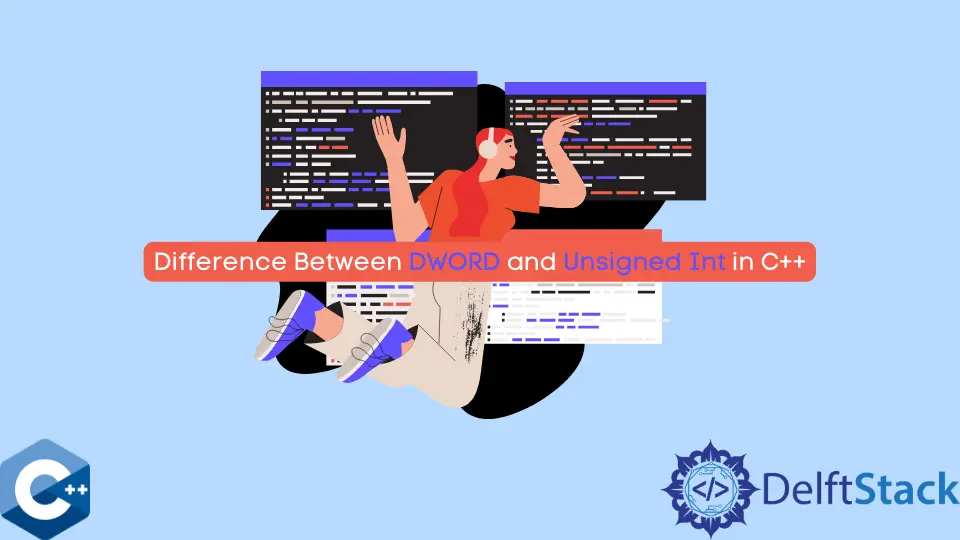Difference Between DWORD and Unsigned Int in C++
-
DWORD -
unsigned int -
Understanding the Difference Between
DWORDandunsigned intin C++ -
Best Practices and Importance of Using
DWORDandunsigned int - Conclusion

This article provides a comprehensive overview of DWORD and unsigned int in C++, covering their definitions, importance, differences, and best practices in data type selection.
DWORD
The importance of DWORD in C++ lies in its role within Windows programming, specifically in interfacing with the Windows API. As a typedef for unsigned long, DWORD represents a 32-bit unsigned integer commonly used for various purposes such as handling memory addresses, file sizes, and API function parameters.
Its significance stems from its integration with Windows-specific functionalities, allowing developers to interact seamlessly with the underlying operating system. By leveraging DWORD, programmers can access a wide range of system-level operations and resources, making it an essential component in the development of Windows applications and systems software.
unsigned int
unsigned int holds importance in C++ due to its versatility and portability across different platforms and compilers. As a standard data type, it provides a reliable way to represent unsigned integers, allowing for efficient arithmetic operations and memory utilization in a wide range of applications.
Its flexibility makes it suitable for general-purpose programming tasks, from simple numerical calculations to complex algorithms. Additionally, unsigned int promotes code portability by ensuring consistent behavior across diverse computing environments, enabling developers to write code that can be easily migrated between systems without modification.
Overall, unsigned int serves as a fundamental building block in C++ programming, facilitating the development of robust and platform-independent software solutions.
Understanding the Difference Between DWORD and unsigned int in C++
In C++ programming, understanding the nuances between various data types is crucial for writing efficient and portable code. Two commonly used data types for representing unsigned integers are DWORD and unsigned int.
DWORD and unsigned int are both used to store unsigned integers in C++, but they have different origins, usage contexts, and implications for portability.
While they might seem similar at first glance, there are important distinctions between them that developers need to be aware of.
In C++, DWORD and unsigned int are both data types used to represent unsigned integers. However, there are some differences between them:
| Aspect | DWORD |
unsigned int |
|---|---|---|
| Origin and Platform Dependency | Defined in Windows environments, often within WinAPI, as a typedef for unsigned long. |
Standard C++ data type, its size varies depending on the platform and compiler. |
| Portability | Specific to Windows platforms and may not be available outside Windows environments without additional definitions. | More portable as it’s part of the standard C++ library and available across different platforms and compilers. |
| Header Inclusion | Requires inclusion of appropriate Windows header, such as windows.h. |
Doesn’t require any specific headers as it’s part of the standard C++ library. |
| Naming Convention | Follows Windows API convention, D for Double (32 bits), and WORD historically referring to a machine word (usually 16 bits). |
Generic and descriptive name indicating an unsigned integer data type with size determined by the compiler and platform. |
| Dependencies | Dependent on the Windows operating system and its associated libraries. | Not dependent on any specific platform or library, available in any standard-compliant C++ environment. |
| Usage | Commonly used in Windows programming, especially with WinAPI functions and structures. |
Utilized in general C++ programming scenarios where platform independence is desired. |
DWORD is a Windows-specific data type typically used in Windows programming, while unsigned int is a standard C++ data type that works across different platforms.
DWORD relies on Windows-specific libraries and may not work outside of Windows environments without additional definitions. DWORD is not a type in C++; it is instead defined in <windows.h>.
In contrast, unsigned int is more portable and doesn’t require any specific headers, as it’s part of the standard C++ library. The naming convention for DWORD follows Windows API standards, whereas unsigned int has a generic name indicating an unsigned integer data type.
DWORD depends on the Windows operating system, whereas unsigned int is independent of any specific platform or library. DWORD is commonly used with WinAPI functions and structures, whereas unsigned int is used in general C++ programming scenarios where platform independence is desired.
Future versions of C++ could have a slightly different definition of the unsigned int (which would still adhere to the C++ guidelines), whereas the DWORD is unlikely to change.
Let’s illustrate the differences between DWORD and unsigned int with a simple code example:
#include <iostream>
// Windows specific header for DWORD
#include <windows.h>
int main() {
// Using DWORD
DWORD dwordVariable = 4294967295; // Maximum value for a DWORD
// Using unsigned int
unsigned int uintVariable = 4294967295; // Maximum value for an unsigned int
// Print values
std::cout << "DWORD Variable: " << dwordVariable << std::endl;
std::cout << "Unsigned Int Variable: " << uintVariable << std::endl;
return 0;
}
In this example, we begin by including the necessary headers. Since DWORD is specific to Windows environments and is typically used in conjunction with Windows API functions, we include <windows.h>.
We then define our main() function.
Within the main() function, we declare two variables: dwordVariable of type DWORD, and uintVariable of type unsigned int. Both variables are initialized with the maximum possible value for their respective data types (4294967295 in decimal or 0xFFFFFFFF in hexadecimal), representing the largest 32-bit unsigned integer.
Next, we print the values of both variables using std::cout.

When we run the code, the output would display the same value for both DWORD and unsigned int variables, which is 4294967295.
This demonstrates that both data types are capable of storing the same range of values. However, it’s essential to consider portability and usage context when choosing between them in real-world programming scenarios.
The primary difference between DWORD and unsigned int lies in their origins and usage contexts. While DWORD is specific to Windows environments and is commonly used in Windows programming, unsigned int is a standard C++ data type that is portable across different platforms.
Best Practices and Importance of Using DWORD and unsigned int
Consistency
When working within Windows environments and interacting with WinAPI functions and structures, it’s best practice to use DWORD for consistency and adherence to Windows programming conventions. Conversely, in cross-platform development or when portability is a concern, favor unsigned int to ensure compatibility across different platforms and compilers.
Contextual Usage
Choose the appropriate data type based on the specific requirements of your project. If your application relies heavily on Windows-specific functionalities, DWORD may be more suitable. However, for general-purpose programming tasks or when targeting multiple platforms, unsigned int provides greater flexibility and portability.
Header Management
Be mindful of header inclusion when using DWORD. Ensure that the appropriate Windows header, such as windows.h, is included to access DWORD definitions. In contrast, unsigned int doesn’t require any specific headers, simplifying code management and reducing dependencies.
Naming Clarity
Follow naming conventions that enhance code readability and maintainability. While DWORD follows Windows API standards, unsigned int provides a more generic and descriptive name. Choose the data type that aligns with your project’s naming conventions and coding standards.
Platform Compatibility
By leveraging both DWORD and unsigned int, developers can ensure their code remains compatible across different platforms. DWORD facilitates seamless integration with Windows-specific functionalities, while unsigned int promotes portability and compatibility with non-Windows environments.
Code Maintainability
Using the appropriate data type for the task at hand enhances code clarity and maintainability. DWORD communicates the intent to work with Windows-specific data, while unsigned int indicates a standard unsigned integer.
Consistently applying these data types improves code readability and facilitates easier maintenance and debugging.
Flexibility and Adaptability
Employing a combination of DWORD and unsigned int allows developers to adapt their code to varying project requirements. Whether developing Windows-specific applications or cross-platform software, having the versatility to choose between these data types ensures the code remains adaptable to changing needs and environments.
Industry Standards Compliance
Following best practices in data type selection aligns with industry standards and coding conventions. By utilizing DWORD in Windows programming contexts and unsigned int for platform-independent development, developers adhere to established norms and contribute to code consistency and interoperability within the software development community.
Conclusion
Understanding the nuances between DWORD and unsigned int is essential for efficient and effective C++ programming. DWORD, primarily utilized in Windows environments, offers direct access to Windows-specific functionalities, while unsigned int provides portability across different platforms.
Both data types play crucial roles in various programming contexts, offering flexibility and adaptability to developers. By adhering to best practices in data type selection, such as choosing the appropriate data type based on project requirements and following naming conventions, developers can enhance code readability, maintainability, and compatibility.
Ultimately, leveraging the strengths of both DWORD and unsigned int ensures the development of robust, platform-independent software solutions.
Husnain is a professional Software Engineer and a researcher who loves to learn, build, write, and teach. Having worked various jobs in the IT industry, he especially enjoys finding ways to express complex ideas in simple ways through his content. In his free time, Husnain unwinds by thinking about tech fiction to solve problems around him.
LinkedIn